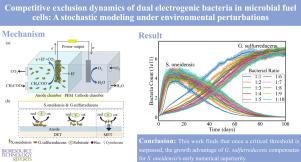微生物燃料电池中双致电细菌的竞争排斥动力学:环境扰动下的随机模型
Q1 Environmental Science
引用次数: 0
摘要
微生物燃料电池(MFCs)利用生电细菌将有机物转化为电能,提供了一种可持续和环保的能源解决方案。由于其电子转移机制不同而又互补,因此,双歧杆菌和硫还原双歧杆菌是mfc研究的关键模式生物。本研究采用基于Gillespie算法的随机建模方法,模拟了这两种细菌在不同条件下的生长动态。研究重点是建立温度和ph依赖的生长模型,分析这些因素对细菌种群的影响。仿真结果与已知的最优条件吻合良好,验证了Gillespie算法对环境影响的响应能力。此外,底物浓度和初始细菌种群比例的影响表明这些因素如何影响细菌相互作用。这项工作证明了Gillespie算法在捕获电致细菌的复杂动力学方面的有效性,为优化mfc操作和推进生物电化学技术提供了理论见解。本文章由计算机程序翻译,如有差异,请以英文原文为准。

Competitive exclusion dynamics of dual electrogenic bacteria in microbial fuel cells: A stochastic modeling under environmental perturbations
Microbial fuel cells (MFCs) utilize electrogenic bacteria to convert organic matter into electricity, providing a sustainable and environmentally friendly energy solution. S. oneidensis and G. sulfurreducens are key model organisms in MFCs research due to their distinct yet complementary electron transfer mechanisms. This study employs a Gillespie algorithm-based stochastic modeling approach to simulate the growth dynamics of these two bacteria under varying conditions. The research focuses on constructing temperature and pH-dependent growth models to analyze the impacts of these factors on bacterial populations. Simulation results align well with known optimal conditions, validating the capability of the Gillespie algorithm to respond to environmental influences. Additionally, the effects of substrate concentration and initial bacterial population ratios demonstrate how these factors affect bacterial interactions. This work demonstrates the effectiveness of the Gillespie algorithm in capturing the complex dynamics of electrogenic bacteria, offering theoretical insights into optimizing MFCs operations and advancing bio-electrochemical technologies.
求助全文
通过发布文献求助,成功后即可免费获取论文全文。
去求助
来源期刊

Bioresource Technology Reports
Environmental Science-Environmental Engineering
CiteScore
7.20
自引率
0.00%
发文量
390
审稿时长
28 days
 求助内容:
求助内容: 应助结果提醒方式:
应助结果提醒方式:


